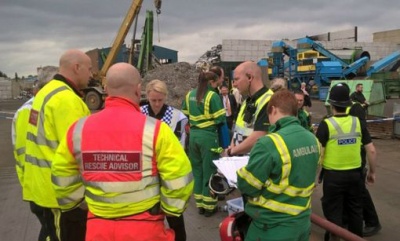Deaths in the waste sector fell last year, but it is still amongst the most dangerous in Britain
 Six people were fatally injured in the waste and recycling industry in 2015/16, according to provisional statistics released by the Health and Safety Executive (HSE), meaning the sector still has one of the highest rates of worker fatalities in Great Britain.
Six people were fatally injured in the waste and recycling industry in 2015/16, according to provisional statistics released by the Health and Safety Executive (HSE), meaning the sector still has one of the highest rates of worker fatalities in Great Britain.
The HSE, Britain’s national regulator for workplace health and safety (and counterpart to HSENI in Northern Ireland), has released annual data of fatal accidents occurring in the work place in key industrial sectors during 2015/16.
Six people were fatally injured in waste and recycling industries during this time, which is less than the previous year, in which 11 were killed, and lower than the five-year average of seven. However, the rate of fatalities in the sector for the year was 5.71 deaths for every 100,000 people working in the sector, compared to the five-year average of 5.59.
This rate is much greater than those of the construction and manufacturing sectors, which have rates of 1.62 and 0.55 respectively. Only the agricultural sector had a higher rate with 9.12 deaths per 100,000 people.
Across all sectors, 144 people were killed at work, which is a slight increase from 142 in 2014/15. However, the rate of work-related deaths in Britain has reduced by over 50 per cent in the last two decades, and is now amongst the lowest rates in Europe.
The more detailed assessment, which will be released in November, will provide a clearer picture of trends across countries and sectors. This assessment draws data from a larger range of sources, and will be part of the yearly Health and Safety Statistics release.
One of Britain’s most dangerous sectors
The six fatal injuries included in the data for 2015/16 were all sustained by employees, while last year, six of the deaths consisted of members of the public, though the data only includes incidents reported to the HSE so the total number of waste related deaths is likely to be higher than the figure reported. For example, in 2014/15, the Glasgow bin lorry crash that killed six pedestrians and injured 10 more was not included in the statistics.

Four deaths were reported involving collisions with waste vehicles in April, only one of which involved the HSE. These included two incidents where a pedestrian was hit by a refuse vehicle, one in which a car collided with a refuse vehicle and one involving a member of a bin crew being hit by his own vehicle.
Last week (7 July), five workers were killed and one injured when a 4.5 metre concrete wall collapsed at a scrap metal recycling facility in Birmingham, covering the men in tonnes of concrete and metal that was being held back by the wall. An investigation is currently underway to find out why the structure collapsed.
Britain should ‘always be looking to improve and to prevent incidents’
Commenting on the general figures, Martin Temple, HSE Chair, said: “One death at work or life needlessly shortened is one too many and behind every statistic lies a real story of loss and heartbreak and families left to grieve.
“Britain has one of the best health and safety systems in the world, but we should always be looking to improve and to prevent incidents that cost lives.
“This year HSE travelled the country asking industry representatives, employers, unions, workers and others what they could do to help GB work well. The response was hugely encouraging and I would like to ask people to deliver on the commitments made, that will help keep Britain’s workers alive.”
The full 2015/16 HSE report can be viewed on the HSE website.







